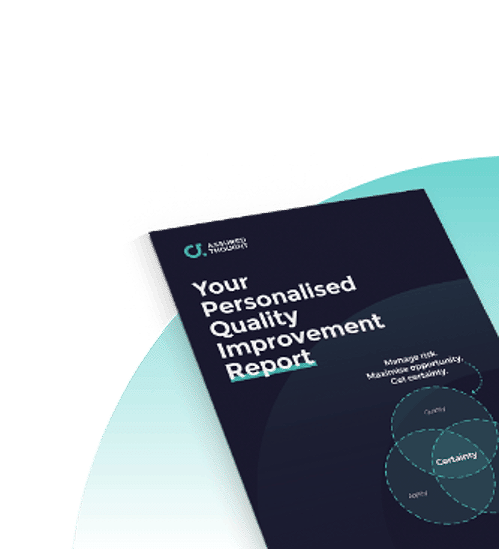Resource
The £5 million bug hiding in your release pipeline
29 Aug 2025
The Tricentis 2025 Quality Transformation Report reveals some startling figures about the financial services industry. In this month’s Assured Thought blog, Kevin Palmer, our Client Services Director, filters the report through his 20 years of quality industry experience to sift out the key points and provide responses: the issues your firm ought to know about and the actions your firm can take to address them.
The latest Tricentis Quality Transformation Report has landed on my desk, and whilst it makes for fascinating reading in any case, it's particularly thought-provoking if you're working in financial services. The statistic that caught my attention? Nearly half of financial services firms are losing more than £5 million each year due to poor software quality. That's not a typo, and it's not an abstract industry statistic; it could well be impacting your organisation's bottom line.
The speed trap we've all fallen into
After twenty years in quality engineering, I've observed the pendulum swing dramatically towards speed at any cost. The report validates what I'm seeing across our financial services clients: 45% of organisations now prioritise delivery speed over software quality, and a notable 63% admit to deploying code without fully testing it.
Here's the reality for financial services: this isn't simply about user experience or minor glitches. We're dealing with potential regulatory compliance failures, security vulnerabilities and system outages that could trigger FCA investigations and seriously damage customer trust.
Recently, a senior technology leader at a major UK bank shared the following with me: ‘We're releasing twice as fast as we were two years ago, but our incident rate has tripled.’ The mathematics here are concerning: short-term velocity gains are being undermined by long-term stability costs.
The hidden costs of cutting corners
The report shows that financial services firms are the hardest-hit global sector when it comes to quality failures. However, the numbers don't tell the whole story about the human impact. I'm witnessing brilliant development teams experiencing burnout from constant firefighting; QA professionals feeling demoralised by being bypassed in the rush to release; and leadership gradually losing confidence in their technology capabilities.
Technical debt compounds these pressures. Legacy systems built for a different era are struggling under modern demands, and every shortcut taken today becomes tomorrow's challenge. One client recently calculated that 40% of their development capacity was being consumed by maintaining and patching systems that had been ‘temporarily’ fixed over the past three years.
The communication challenge
The report identifies poor communication between development and QA teams as the primary barrier to quality (33% of respondents), followed closely by disconnect between leadership and development teams (29%). This is an accurate reflection of what I’ve observed in the field.
Too often, developers view testing as a bottleneck, testers feel side-lined by DevOps practices and leadership measures success purely by deployment frequency. This isn't just a process issue; it's a cultural one that requires thoughtful intervention.
In my experience, the most successful transformations begin with alignment. When everyone, from the C-suite to the junior developers, understands that quality and speed aren't opposing forces but complementary capabilities. With that collaborative understanding in place, genuine progress follows.
The AI opportunity (and consideration)
Here's where the report becomes genuinely exciting. More than 80% of IT professionals believe AI will help teams deliver both quality and speed in unison. Nearly 90% of organisations can now effectively measure ROI from generative AI in software development. This is no longer theoretical; it's happening.
However, and this is particularly important for financial services, AI adoption should be measured and responsible. The report highlights concerns around AI bias (38%) and over-reliance (38%). In our sector, where algorithmic decisions can significantly impact people's financial lives, these concerns aren't just valid; they're regulatory considerations.
I'm particularly interested in the emerging role of AI agents in testing. The report shows 99.89% of respondents see value in autonomous testing, with expected benefits for software speed (28%) and overall quality (28%). At Assured Thought, we're already piloting AI-driven test case generation and maintenance with several clients, and the early results are encouraging.
What financial services leaders should consider now
1. Redefine your quality metrics: Consider moving beyond measuring quality by speed alone. Establish balanced scorecards that include customer impact, regulatory compliance and technical debt indicators alongside delivery velocity.
2. Invest in alignment, not just tools: Before implementing new testing platforms or AI solutions, address your communication gaps. Regular alignment sessions between your development, testing and business teams often deliver more immediate value than any technology purchase.
3. Build AI literacy thoughtfully: Your teams need to understand AI's limitations. In financial services, this is both a regulatory and risk management consideration. Invest in training that helps your teams work effectively with AI.
4. Address technical debt strategically: With 34% citing technical debt as their biggest quality obstacle, this merits attention. Consider dedicating time and budget to debt reduction; it's infrastructure investment, not overhead.
5. Explore autonomous testing: AI agents are set to transform testing, so consider starting small but starting now. Focus on test case maintenance and result analysis, the areas where the report shows the greatest expected impact.
The quality transformation opportunity
The report's central message is clear: organisations that balance velocity with quality discipline will lead the next wave of digital transformation. Those that don't may face mounting costs, increased customer churn and regulatory challenges.
For financial services firms, the stakes are particularly high. We operate in a sector where trust is our primary currency, and quality issues don't just cost money – they can also affect the fundamental relationship we have with our customers.
The path forward isn't about choosing between speed and quality; it's about building the capabilities, culture and technology foundations that enable both. The £5 million question isn't whether you can afford to invest in quality transformation; it's whether you can afford to not explore it.


